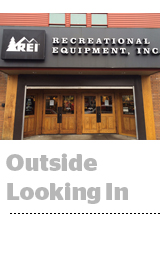 When the outdoor recreation retailer REI closed its shops for Black Friday, the biggest sales day of the year for many stores, it was testing brand appeal against strong short-term revenue, as well as its out-of-home (OOH) media and data services.
When the outdoor recreation retailer REI closed its shops for Black Friday, the biggest sales day of the year for many stores, it was testing brand appeal against strong short-term revenue, as well as its out-of-home (OOH) media and data services.
REI has grown its OOH media from nothing two to three years ago to about 15% of its marketing mix, said Amy Ball, the company’s senior manager of advertising and branded content.
“The ability to measure [OOH] has allowed us to prove to our leadership that this isn’t just upper-funnel,” Ball said. “That it drives foot traffic and pulls people into consideration and purchase.”
REI’s OOH holiday campaign last year was limited to Washington, DC, Denver and the San Francisco Bay Area and are expanding to another one or two markets in the Northeast in 2018. But even if the number of REI billboards grows slowly, OOH can be a bigger part of the media mix because of the associated data costs and because some mobile networks now fall under OOH budgets.
The OOH campaign last year promoting its “OptOutside” Black Friday initiative, for instance, began incorporating LiveRamp’s cross-channel identity-matching service to create audience segments for targeting and attribution, Ball said.
REI also worked with Vistar Media, an OOH and mobile advertising company, to target ads across digital signage networks in office buildings, malls and gyms, as well as to geo-fenced areas around stores.
Vistar sources location data for targeting and measurement from mobile SDK and GPS partnerships, with LiveRamp as one of its main location data providers through its acquisition of Arbor, according to CEO Michael Provenzano. Despite operating a bidder, he said, Vistar never uses bidstream location data because its quality and provenance are a constant question mark.
A “surprising metric” REI was able to see by matching its first-party audience to LiveRamp’s identity match and then Vistar’s location tracking was that people exposed to the OOH campaign were 3.6 times more likely to show up in a store, Ball said.
Marketers believe in OOH in theory, Ball said, “but until you can pull out numbers, it’s hard to allocate dollars behind the channel.”
OOH media is an underinvested channel in marketing because of this “missing ROI measurement component,” Provenzano said.
Mobile data and digital signage won’t make OOH measurable like online CPA campaigns, where attribution is often doled out immediately or within days, Provenzano said.
But the data and methodology now exist to tie OOH media to store visitation or sales lift. He compared OOH attribution to the kind of studies a company like Nielsen and its Nielsen Catalina Solutions subsidiary might run for a retailer, with the measurement studies typically taking a few months following the campaign.
This post was syndicated from Ad Exchanger.

More Stories
Special PR makes Global PR Agency of the Year shortlist
Meta Stands to Lose Tens of Billions of Ad Spend in Impending FTC Antitrust Trial
Where kids’ books go bad: The Worst Children’s Library shocks parents